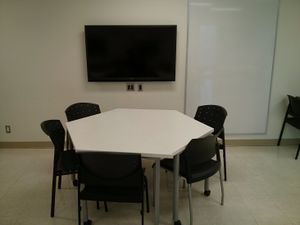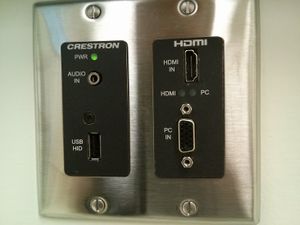Difference between revisions of "Active Learning Classroom"
Chris Tyler (talk | contribs) (→Bring Your Own Device (BYOD)) (Tags: Mobile edit, Mobile web edit) |
Chris Tyler (talk | contribs) (→Bring Your Own Device (BYOD)) |
||
| (3 intermediate revisions by the same user not shown) | |||
| Line 1: | Line 1: | ||
[[Category:SPO600]][[Category:SBR600]] | [[Category:SPO600]][[Category:SBR600]] | ||
An Active Learning Classroom is a space configured to support a learning approach called [http://en.wikipedia.org/wiki/Active_learning Active Learning], which focuses the responsibility of learning on the learners. Essentially, this involves hands-on, interactive, and collaborative activities between students, and the role of the professor becomes that of coach and guide. | An Active Learning Classroom is a space configured to support a learning approach called [http://en.wikipedia.org/wiki/Active_learning Active Learning], which focuses the responsibility of learning on the learners. Essentially, this involves hands-on, interactive, and collaborative activities between students, and the role of the professor becomes that of coach and guide. | ||
| + | |||
| + | == Active Learning Classrooms at Newnham Campus == | ||
| + | |||
| + | Newnham Campus has a number of active learning classrooms, including B1024, B1079, B3040, and K1263. Each of these rooms has multiple work pods containing: | ||
| + | * Reconfigurable work tables and chairs. Most of these pods have two trapezoidal tables that can be arranged into a hexagon, V-shape, or straight line, and five or six chairs. | ||
| + | * A whiteboard, arranged vertically. | ||
| + | * A large LCD display. | ||
| + | * Power outlets. | ||
| + | |||
| + | Seating at the pods will vary by class -- your professor may assign seating sometimes, and you may form your own groups at other times. | ||
== Active Learning Classrooms at Seneca@York == | == Active Learning Classrooms at Seneca@York == | ||
| Line 30: | Line 40: | ||
Please feel free to rearrange the furniture in your pod as you see fit. Please return it to (roughly) the original position when you're done. | Please feel free to rearrange the furniture in your pod as you see fit. Please return it to (roughly) the original position when you're done. | ||
| − | When reviewing things on the screen, a V-shaped arrangement around the screen may prove effective; when holding a group discussion, | + | When reviewing things on the screen, a V-shaped arrangement around the screen may prove effective; when holding a group discussion, a square or hexagontal configuration may be best. |
== Using the Whiteboard == | == Using the Whiteboard == | ||
| Line 42: | Line 52: | ||
If your device has a different connector, such as DisplayPort, MyDP, or mini/micro-HDMI, please bring appropriate adapters. | If your device has a different connector, such as DisplayPort, MyDP, or mini/micro-HDMI, please bring appropriate adapters. | ||
| − | If you do not have a suitable device, you may want to consider the [ | + | If you do not have a suitable device, you may want to consider the Computing Common's [https://inside.senecacollege.ca/its/services/loaners/policy.html laptop loan program]. |
== Using the Screen (and Speakers) == | == Using the Screen (and Speakers) == | ||
| − | [[File:Alc-panel.jpg|right|thumb|The wall panel mounted beneath each screen in the | + | [[File:Alc-panel.jpg|right|thumb|The wall panel mounted beneath each screen in the Seneca@York ALCs.]]To use the screen, simply connect your laptop (or smartphone) to the panel below the screen using the appropriate cable. The screen should come on within a few seconds of sending a signal, unless the A/V system is not turned on. HDMI cables carry audio; if you're using a VGA connection, use the accompanying 3.5 mm audio plugs to connect your headphone/speaker output to the audio input on the wall panel. |
=== Screen Sharing and Blanking === | === Screen Sharing and Blanking === | ||
| − | The touchscreen LCD panel located at the | + | The touchscreen LCD panel located at the professor's console can be used to share the signal sent to one screen with all the screens in the room (the same image is repeated on each screen). This is used for presentations and for sharing code examples. When a screen is shared, audio is routed to the ceiling speakers. |
The touchscreen LCD panel can also be used to blank specific screens around the room. | The touchscreen LCD panel can also be used to blank specific screens around the room. | ||
A [https://senema.senecac.on.ca/videos/2085/active-learning-classroom-tutorial video tutorial] explains the A/V system. | A [https://senema.senecac.on.ca/videos/2085/active-learning-classroom-tutorial video tutorial] explains the A/V system. | ||
Latest revision as of 14:08, 6 January 2020
An Active Learning Classroom is a space configured to support a learning approach called Active Learning, which focuses the responsibility of learning on the learners. Essentially, this involves hands-on, interactive, and collaborative activities between students, and the role of the professor becomes that of coach and guide.
Contents
Active Learning Classrooms at Newnham Campus
Newnham Campus has a number of active learning classrooms, including B1024, B1079, B3040, and K1263. Each of these rooms has multiple work pods containing:
- Reconfigurable work tables and chairs. Most of these pods have two trapezoidal tables that can be arranged into a hexagon, V-shape, or straight line, and five or six chairs.
- A whiteboard, arranged vertically.
- A large LCD display.
- Power outlets.
Seating at the pods will vary by class -- your professor may assign seating sometimes, and you may form your own groups at other times.
Active Learning Classrooms at Seneca@York
Seneca@York has two active learning classrooms, in the SEQ building. Each of these rooms has multiple work pods containing:- Reconfigurable work tables and chairs. Most of these pods have two trapezoidal tables that can be arranged into a hexagon, V-shape, or straight line, and five or six chairs.
- A whiteboard, arranged vertically.
- A large LCD display.
- Power outlets.
Seating at the pods will vary by class -- your professor may assign seating sometimes, and you may form your own groups at other times.
Rearranging the Furniture
Please feel free to rearrange the furniture in your pod as you see fit. Please return it to (roughly) the original position when you're done.
When reviewing things on the screen, a V-shaped arrangement around the screen may prove effective; when holding a group discussion, a square or hexagontal configuration may be best.
Using the Whiteboard
Please use only the supplied whiteboard markers and eraser on the whiteboard, and please erase the board when you're done.
Bring Your Own Device (BYOD)
This class is configured as a BYOD environment. Please bring a device -- laptop, smartphone, or tablet with a wifi network connection, VGA or HDMI output, and whatever software is appropriate to your course.
If your device has a different connector, such as DisplayPort, MyDP, or mini/micro-HDMI, please bring appropriate adapters.
If you do not have a suitable device, you may want to consider the Computing Common's laptop loan program.
Using the Screen (and Speakers)
To use the screen, simply connect your laptop (or smartphone) to the panel below the screen using the appropriate cable. The screen should come on within a few seconds of sending a signal, unless the A/V system is not turned on. HDMI cables carry audio; if you're using a VGA connection, use the accompanying 3.5 mm audio plugs to connect your headphone/speaker output to the audio input on the wall panel.Screen Sharing and Blanking
The touchscreen LCD panel located at the professor's console can be used to share the signal sent to one screen with all the screens in the room (the same image is repeated on each screen). This is used for presentations and for sharing code examples. When a screen is shared, audio is routed to the ceiling speakers.
The touchscreen LCD panel can also be used to blank specific screens around the room.
A video tutorial explains the A/V system.

